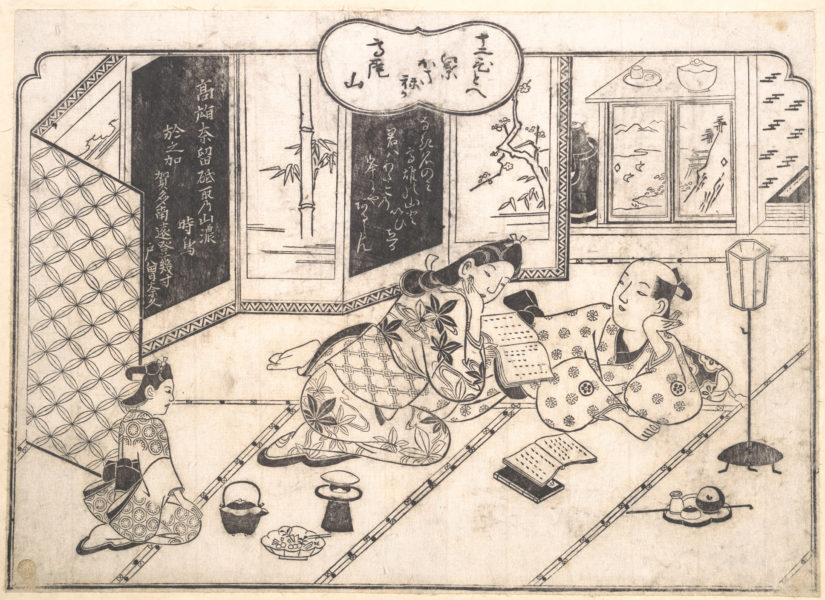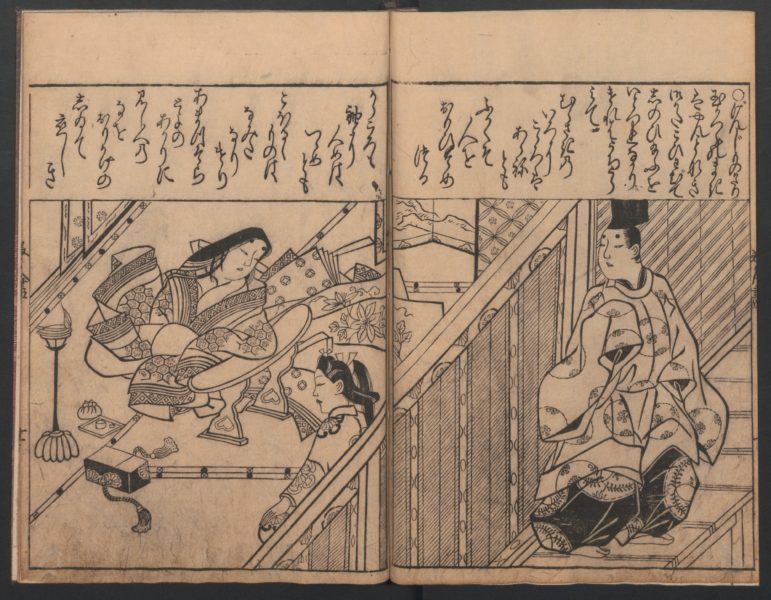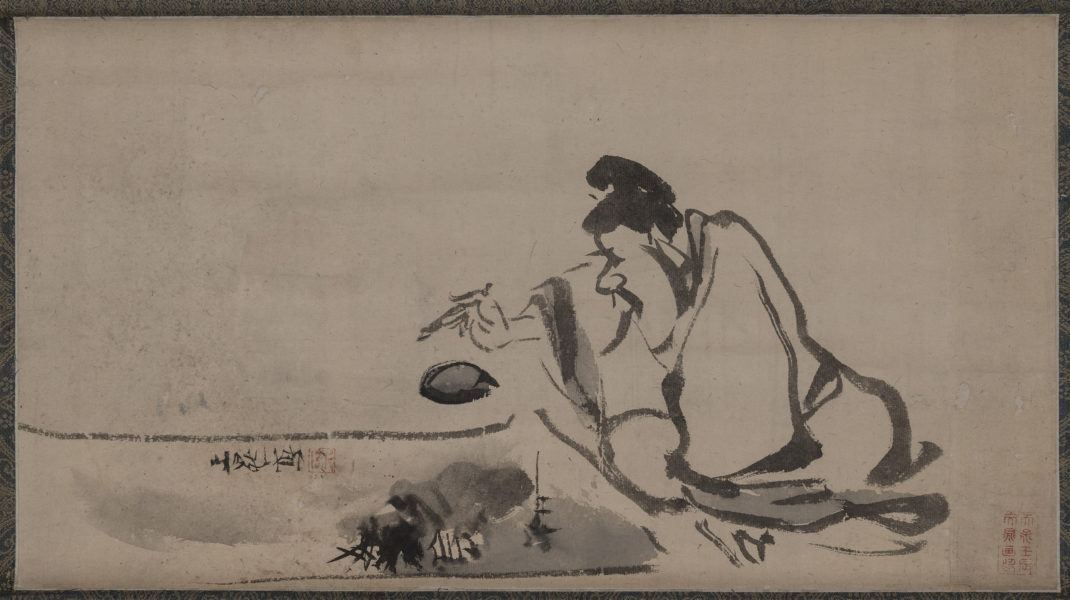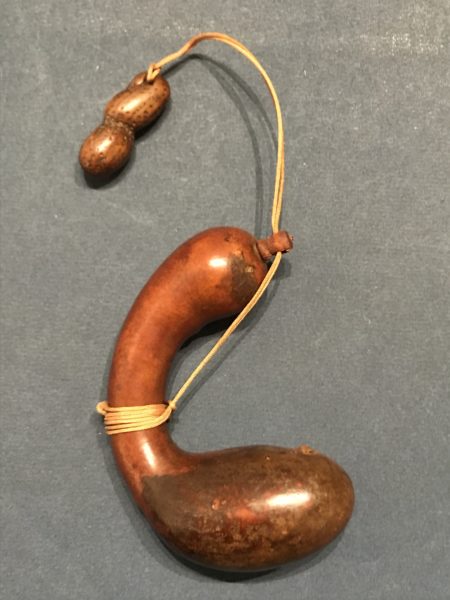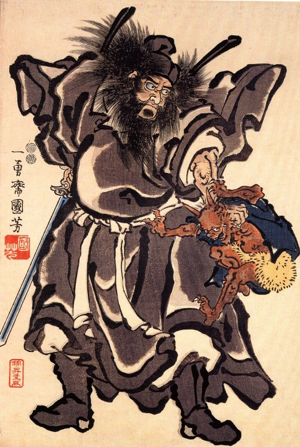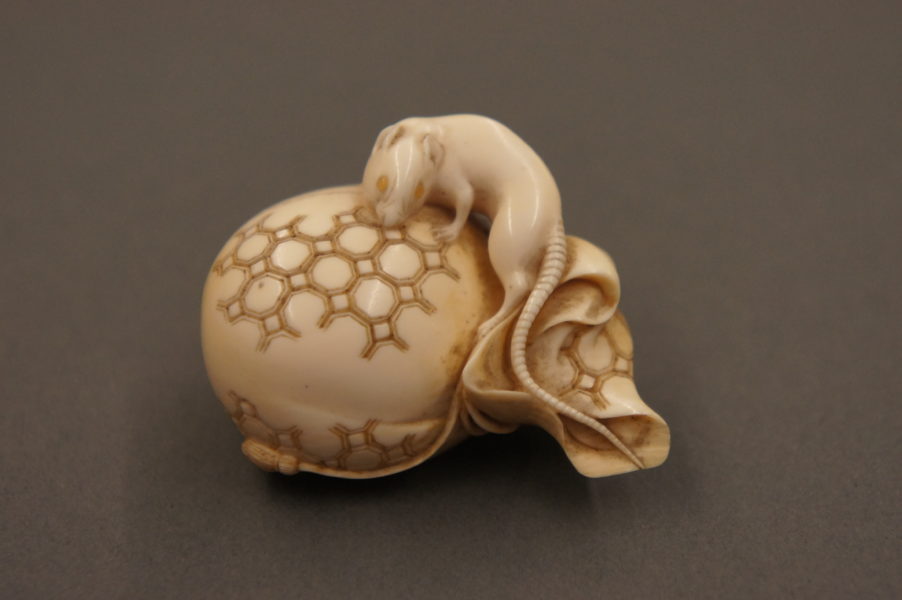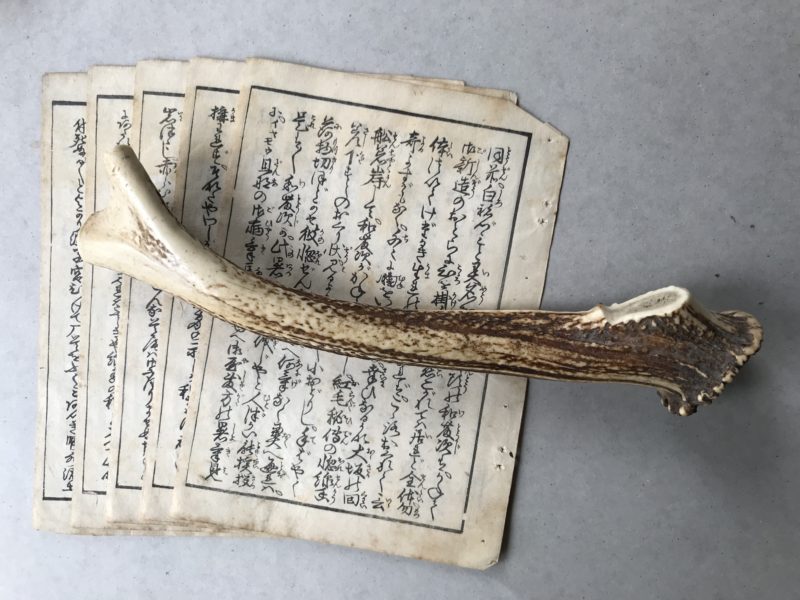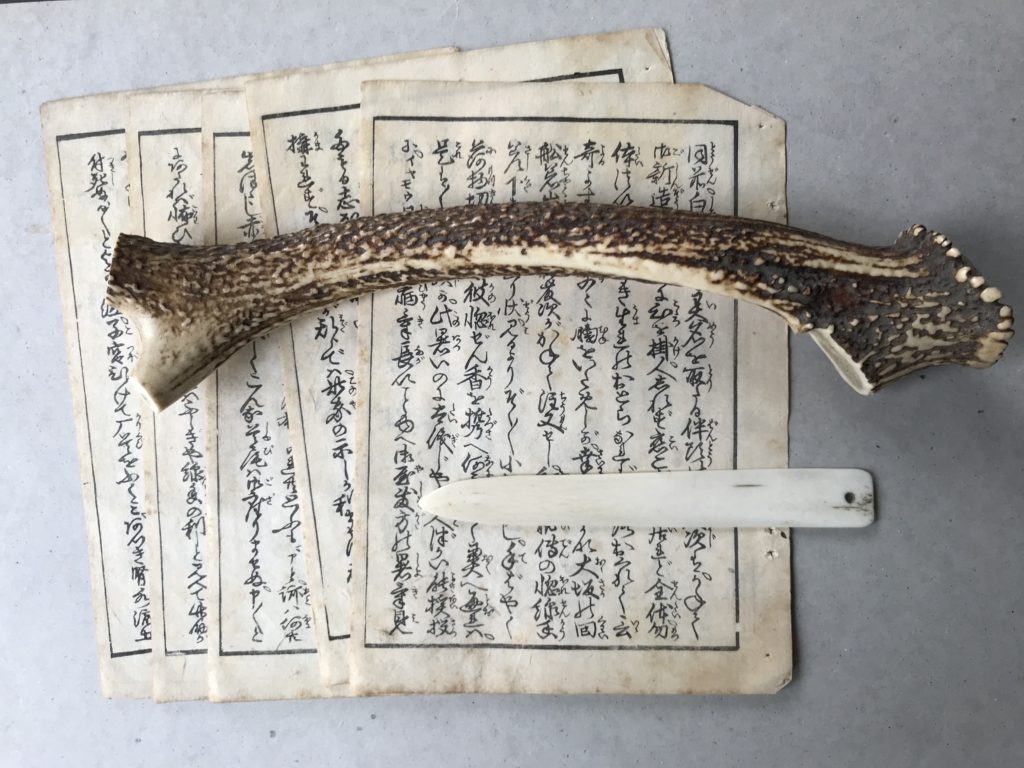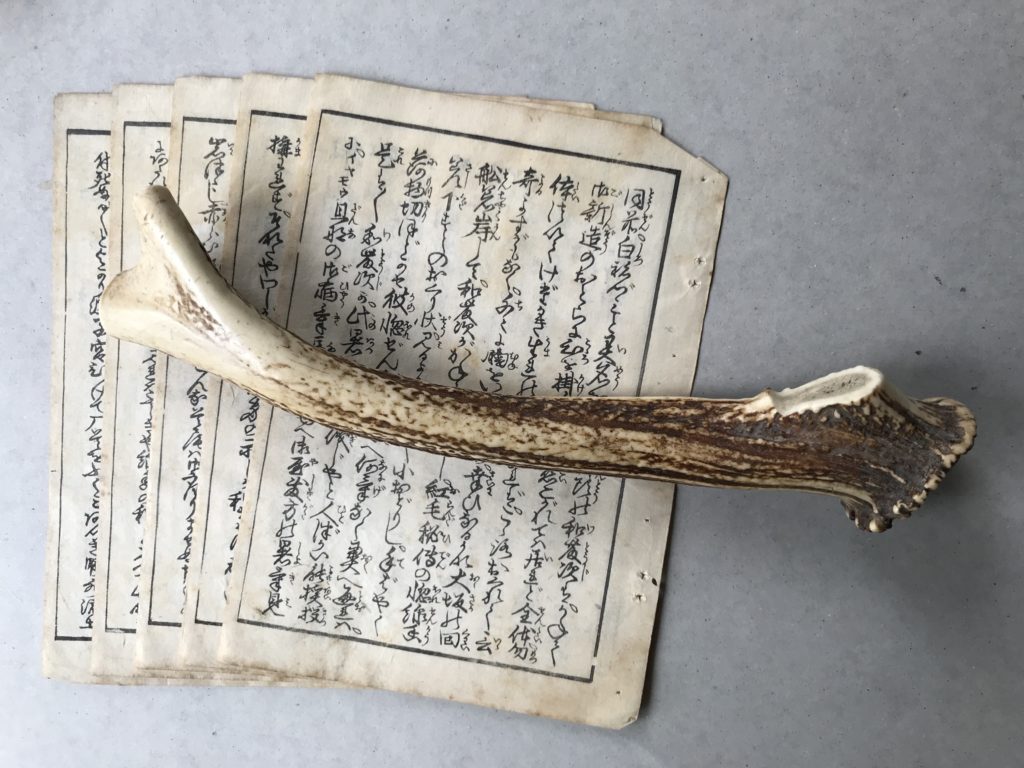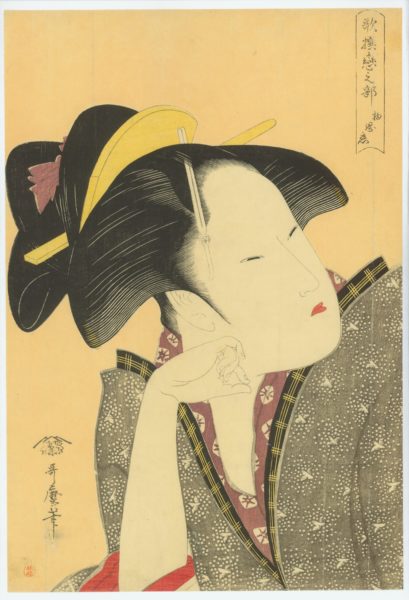Just to give you some idea of how important a book illustrator Hishikawa Moronobu was, please enjoy the following inventory. And also, please note that quite a few are signed ‘Japanese painter,’ Yamato eshi (大和繪師) – added after the references. Of special interest is the wording ‘ezukushi‘ in the books’ titles, a sure indication that the work was conceived as ‘a collection of pictures,’ not a set of illustrations to a text of some kind. I may well be tempted to add a few more references at some later moment.
Books illustrated by Hishikawa Moronobu[1]
Ehon, that is picture books dating to the 1670s, number a total of 6, Enpon, that is works of erotic content, numbering 12:
Buke hyakunin isshu (武家百人一首) 1 vol., 1672 [M 1; 1295]
Wakoku bijin asobi (倭国美人あそび) 1 vol., 1673 [S 213]
Ise Genji shokushi (伊勢源氏色紙) 1 vol., 1674 [S 80]
Wakashu asobi kyara no en (若衆遊伽羅之緑) 1 vol., 1675 [S 213]
Kyara makura (伽羅枕) 1 vol., 1676 [S 130]
Genji kyasha makura (源氏きやしや枕) 1 vol., 1676 [S 130]
Edo suzume (江戸雀) 12 vols., 1677 [M –; 1296]
Koi no shina makura (戀の品枕) 1 vol., 1677 [S 134]
Komurasaki (小むらさき) 1 vol., 1677 [S 134]
Hyakunin isshu zōsanshō (百人一首像讃抄) 3 vols., I/1678 [M 2; 1297]
Yoshiwara koi no michibiki (吉原戀の道引) 1 vol., 1678 [M 3; 1298]
Kokon yakusha monogatari (古今役者物かたり) 1 vol., 1678 [M 4; 1299]
Ehon zassho makura (繪本雜書枕) 1 vol., 1678 [S 93]
Koi no iki utsushi (戀の息うつし) 1 vol., 1678 [S 134]
Wagō dōjin (和合同塵) 1 vol., 1678 [S 213]
Ise monogatari kashiragakishō (伊勢物語頭書抄) 3 vols., 1679 [M –; 1300]
Hana no katarai (枕華の語ひ) 12 ōban, 1679 [S 182]
Koi no mutsugoto shijūhatte (戀のむつごと四十八手) 1 vol., 1679 [S 135]
In the 1680s, we see a total of 34 ehon or picture books, and 19 enpon or erotic works:
Ningen bureikō (人間不礼考) 1 vol., 1680 [M 5; 1301; S 176] 大和繪師
Ogurayama hyakunin isshu (小倉山百人一首) 1 vol., 1680 [M 6; 1302]
Yamato shinō ezukushi (大和侍農) 1 vol., V/1680 [M 7; 1303] 大和繪師
Yamato ezukushi (大和繪つくし) 1 vol., V/1680 [M 8; 1304] 大和繪師
Yamato mushae (大和武者繪) 1 vol., 1680 [M 9; 1305] 大和繪師
Tsukinami no asobi (月次のあそび) 1 vol., VII/1680 [M 10; 1306] 日本繪師
Nenjū gyōji no zu (年中行事之図) 1 vol., 1680 [M –; 1308]
Kōshoku itoyanagi (好色糸柳) 2 vols., 1680 [S 135]
Yamato yorozu ezukushi (大和万繪つくし) 1 vol., VII/1681 [M 11; 1309]
Ukiyo hyakunin onnae (浮世百人女繪) 1 vol., Q/1681 [M 12; 1310]
Sasage no emakura (さゝげの繪枕) 1 vol., 1681 [S 148]
Toko no okimono (床の置物) 1 vol., 1681 [S 171]
Iwaki ezukushi (岩木繪つくし) 1 vol., I/1682 [M 13; 1311] 大和繪師
Ukiyo zoku ezukushi (浮世続繪尽) 1 vol., I/1682 [M 14; 1312] 大和繪師
Onna kasen shinshō (女歌仙新抄) 1 vol., I/1682 [M 15; 1313]
Saigyō waka shugyō (西行和歌修行) 3 vols., I/1682 [M 16; 1314] 大和繪師
Byōbu kakemono ezukushi (屏風掛物繪尽) 1 vol., I/1701 [M 17; 1315]
Chiyo no tomozuru (千代の友つる) 1 vol., I/1682 [M 18; 1316]
[Tōfū hana no omokage (当風花のおもかけ) 1 vol., 16XX [M –; 1342]]
Konokorokusa (このころくさ) 2 vols., Q/1682 [M 19; 1317]
Tōeizan meisho (東叡山名所) 1 vol., II/1682 [M 20; 1318]
Kosode no sugatami (小袖のすがたみ) 1 vol., III/1682 [M 21; 1319]
Wakoku meisho kagami (和国名所鑑) 1 vol., IV/1682 [M 22; 1320]
Uchiwa ezukushi (団扇繪づくし) 1 vol., V/1682 [M 23; 1321] 大和繪師
Yamato no ōyose (大和のおほよせ) 1 vol., VII/1682 [M 24; 1322]
Ukiyo koikusa (浮世戀くさ) 1 vol., 1682 [S 88]
Makurae taizen (まくら繪大ぜん) 3 vols., 1682 [S 302]
Kaboku no makura (花木のまくら) 1 vol., 1682 [S 127]
Bijin ezukushi (美人繪ずくし) 3 vols., V/1683 [M 25; 1323] 大和繪師
Kachō ezukushi (花鳥繪ずくし) 1 vol., V/1683 [M 26; 1324]
Koi no minakami (戀のみなかみ) 1 vol., 1683 [M 27; 1325]
Osana najimi (於佐名那志美) 2 vols., 1683 [S 120]
Koi no tanoshimi (戀の楽) 2 vols., 1683 [S 134]
Koi no hana murasaki (戀の花むらさき) 2 vols., 1683 [S 134]
Tōsei sōryū hinagata (当世早流雛形) 1 vol., I/1684 [M 28; 1326]
Tōsei hina ezukushi (当風品繪ずくし) 1 vol., 1684 [M –; 1327]
Hana no kokakure (花の小かくれ) 1 vol., 1684 [S 182]
Fūryū setchōzu (風流絶暢図) 1 vol., early 1680s [S 196]
Chikuyō shijitsu (竹夭氏日) 1 vol., early 1680s [S 167]
Narihira honcho no shinobi (業平本朝のしのび) 2 vols., early 1680s [S 172]
Kokon bushidō ezukushi (古今武士道繪ずくし) 1 vol., I/1685 [M 29; 1328] 大和繪師
Sanza nasake no kayoiji (山三情の通路) 1 vol., I/1685 [M 30; 1329] 大和繪師
Wakoku shoshoku ezukushi (和国諸職繪つくし) 4 vols., II/1685 [M 31; 1330]
Genji Yamato ekagami (源氏大和繪鏡) 2 vols., IV/1685 [M 32; 1331] 大和繪師
Imayō makura byōbu (今様吉原枕) 1 vol., 1685 [S 80]
Imayō Yoshiwara makura (今様枕屏風) 1 vol., 1685 [S 80]
Yamatoe kongen (大和繪根元) 4 vols., I/1686 [M 33; 1332] 大和畫工
Kōshoku sewa ezukushi (好色世話繪ずくし) 2 vols., 1686 [M –; 1333]
Shinpan – Kōshoku hana no sakazuki (新枕―好色花の盃) 2 vols., 1687 [S 137]
Makura ezukushi (枕繪ずくし) 3 vols., 1687 [S 202]
Nasake no uwamori (情のうわもり) 3 vols., 1687 [S 172]
Igyō senninzukushi (異形仙人つくし) 3 vols., I/1689 [M 34; 1335] 大和繪師
Miyagino (みやぎの) 3 vols., late 1680s [M –; 1334]
And, finally, in the 1690s, we can identify 7 ehon, or picture books, and only 2 enpon, or works of erotic content:
Musha sakura (武者さくら) 1 vol., 1690 [M 35; 1336]
Tōkaidō bunken ezu (東海道分間繪図) 5 vols., 1690 [M ; 1337]
Yokei tsukuri niwa no zu (余景作り庭の図) 1 vol., V/1691 [M 36; 1307] 日本畫師
Wake no kongen (わけのこんげん) 1 vol., 1691 [S 213]
Kedamono ehonzukushi (獣繪本つくし) 1 vol., 1694 [M 37; 1338]
Wakoku hyakujo (和国百女) 1 vol., I/1695 [M 38; 1339]
Sugatae hyakunin isshu (姿繪百人一首) 3 vols., 1695 [M –; 1340]
Shinkan – Goreikō (新刊ー好色五れいかう) 2 vols., 1695 [S 136]
Aruhito no tazune (或人の尋) 2 vols., 1698 [M –; 1341]
[1] The M numbering refers to Matsudaira Susumu, Moronobu Sukenobu ehon shoshi (Nihon shoshigaku taikei, 57). Musashimura: Seishōdō Shoten, 1988; S numbers refer to Shirakura Yoshihiko, Eiri shunga ehon mokuroku. Tokyo: Heibonsha, 2007. Just numbers refer to ‘Ehon, etehon, gafu mokuroku,’ in Ōta Masako (Ed.), Edo no shuppan bunka kara hajimatta imeiji kakumei. Kanazawa: Kanazawa Geijutsugaku Kenkyūkai, 2007.
